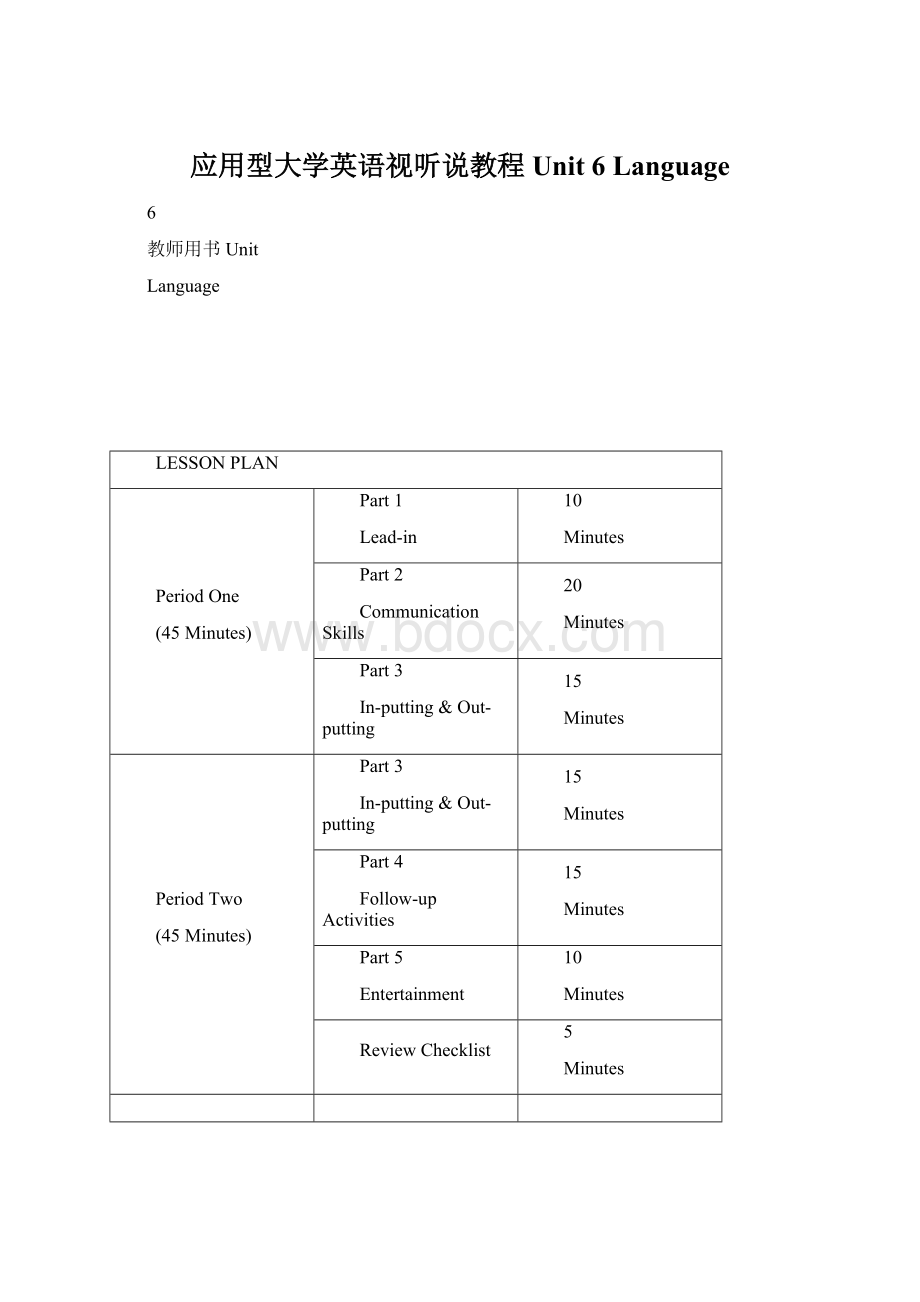应用型大学英语视听说教程Unit 6 Language.docx
《应用型大学英语视听说教程Unit 6 Language.docx》由会员分享,可在线阅读,更多相关《应用型大学英语视听说教程Unit 6 Language.docx(20页珍藏版)》请在冰豆网上搜索。

应用型大学英语视听说教程Unit6Language
6
教师用书Unit
Language
LESSONPLAN
PeriodOne
(45Minutes)
Part1
Lead-in
10
Minutes
Part2
CommunicationSkills
20
Minutes
Part3
In-putting&Out-putting
15
Minutes
PeriodTwo
(45Minutes)
Part3
In-putting&Out-putting
15
Minutes
Part4
Follow-upActivities
15
Minutes
Part5
Entertainment
10
Minutes
ReviewChecklist
5
Minutes
UNITMAP
Inthisunit,youhave:
Part1Lead-in
⏹Activity1:
Listening:
Bodylanguage
⏹Activity2:
Viewing:
Howtotalktoyourcat
⏹Activity3:
Speaking:
Howdowecommunicate?
Part2CommunicationSkills
⏹Activity1:
OralFunctions
⏹Activity2:
OralPractice
⏹Task1:
Listening:
Onhousework
⏹Task2:
Viewing:
Titanic
⏹Task3:
Speaking:
Pairwork
Part3In-putting&Out-putting
⏹Activity1:
ListeningtoLearn
⏹Task1:
Listeningforinformation
⏹Task2:
Listeningfordetails
⏹Task3:
Oralpractice:
Takeasurvey
⏹Activity2:
ViewingtoLearn
⏹Task1:
Viewingforinformation
⏹Task2:
Viewingfordetails
⏹Task3:
Oralpractice:
Retelling
Part4Follow-upActivities
⏹Activity1:
ListeningtoLearn
⏹Task1:
Listeningforinformation:
Onlanguage
⏹Task2:
Oralpractice:
Athree-minutespeech
⏹Activity2:
ViewingtoLearn
⏹Task1:
Viewingforinformation:
Ontheworld’sEnglishmania
⏹Task2:
Oralpractice:
Pairwork
Part5Entertainment:
MusicVideoofBodyLanguage
ReviewChecklist
PartⅠ:
Lead-in
Part1Lead-in
Teachingtips
Helpthestudentsunderstandthatbodylanguageisthetypeofcommunicationinwhichapersonusesthebody,includingfacialexpressions,toreacttosituations.Itwillbeofgreatbenefittodevelopone'sabilitytoreadandunderstandsignalsandsignsofbodylanguageasthiswillhelpineasilyunderstandingthenatureofotherhumanbeingsandalsoimprovecommunicationwiththem.
Activity1Listening
BodyLanguage
Tapescript:
Someofusthinkthatwhatwesay(verbalcommunication)ismoreimportantthanhowwesaythat.Researchesshowthatwecouldnotbemorewrong.Doyouknowwhatthenumbers55%-38%-7%mean?
55%body,38%toneand7%words.How1incredible!
Non-verbalcommunicationismoreimportantthanverbal.Wecanbesayingwiseandcleverthingsbutiftheyarenot2coherentwithourbodylanguage,noonewillbelieveus.Whenwearetalkingtootherpeoplewewanttobesurethattheyarelisteningandunderstandus,otherwisewearewastingourprecioustime.Wecanseewhetherapersonislisteningtousby3observingtheirbodymovements.
Let'smakeanexperiment.Whenspeakingtopeople,observeif:
(1).they4maintaineyecontact
(2).theirhandsare5inclinedforward
(3).theyarenoddingtheirheads
(4).theirfeetarepointingtowardsthespeaker
(5).theyoftensmile.
Checktheanswers:
1.incredible2.coherent3.observing4.maintain5.inclined
Teachingtips
⏹Allowthestudentstolistentothepassageoncetogetthegeneralideaofthepassage.Thenletthestudentslistentothetapeagaintopayattentiontosomedetails.
Activity2Viewing
Directions:
WatchthevideoonHowtoTalktoYourCattwice,anddecidewhethereachofthefollowingstatementsistrueorfalse.Ifitisfalse,correctit.
VideoTranscript:
HowtoTalktoYourCat
Sure,youtalktoyourcatnow,butdoesheknowwhattheheckyou’resaying?
Anddoyouunderstandhispurrsandmeows?
Ifnot,it’stimetohaveagoodchatwithyourfurryfriend.
Youwillneed:
oAwillingnesstolooksilly
oAttentiontopaytohissounds
oAworkingknowledgeofcatbodylanguage
Step1:
Mimichissounds
Creategreaterintimacywithyourcatbymimickinghismeows.Justknowingthatyou’reattemptingtospeakhislanguagewillmakehimfeelclosertoyou.
Step2:
Usehisname
Increaseyourchancesofyourcatlisteningtoyoubyusinghisnamewhenyou’reissuingacommand.
Menshoulduseahigher-pitchedvoicewhenspeakingtotheircats,becausecatsrespondbettertosopranos.
Step3:
Watchyourtone
Likehumans,catsseekcluesaboutaperson’smoodbylisteningtohisvoice.Sowhenyoutalktoyourcat,besurethatyourtonematchesthemessageyouwanttoconvey.
Ifyouwantyourcattoknowyou’reupsetthathejustpeedontherug,dowhathismomwoulddo:
Gentlypickhimupbythescruffofhisneckandgrowl.
Step4:
Learnhislanguage
Catshaveabout100wordsintheirvocabularyintheformofmeows,growls,purrsandhisses.Paycloseattentionandyou’llbegintolearnthesoundshemakeswhenhe’shungry,angry,fearfulandsoon.
Step5:
Readhistail
Learnhowtoreadyourcat’stail.Ifonlythetipismoving,he’sirritated.Ifthetailisswingingfromsidetoside,he’sPO’d.Ifhe’scarryinghistailtallandproud,he’shappy.
Step6:
Interpretspeedandvolume
Figureoutkitty’smoodbypayingattentiontothespeedandvolumeofhismewling.Fast,loudsoundsindicateanxiety,whileslow,quietersoundsconveyconfidence.Didyouknow,inancientEgypt,catsweresoreveredthatwhenonedied,theownerplacedembalmedmiceinthecat’scoffinsohe’dhavefoodintheafterlife.
Note:
PO’d:
veryangry(slang;notpolite)
Checktheanswers:
Statements
True/False
CorrectAnswers
1.Inordertohaveagoodchatwithyourcatyouonlyneedawillingnesstolooksilly.
False
Inordertohaveagoodchatwithyourcatyouwillneed:
Awillingnesstolooksilly
Attentiontopaytohissounds
Aworkingknowledgeofcatbodylanguage
2.Whenyoutalktoyourcat,besurethatyourtonematchesthemessageyouwanttoconvey.
True
3.Catshaveabout100wordsintheirvocabularyintheformofmeows,growls,purrsandhisses.
True
4.Fast,loudsoundsindicateanxiety,whileslow,quietersoundsindicateintimacy.
False
Fast,loudsoundsindicateanxiety,whileslow,quietersoundsconveyconfidence.
Activity3Speaking
Directions:
Workinpairs,discussthefollowingquestions.Thenshareyouropinionswiththewholeclass.
HowDoWeCommunicate?
Teachingtips
⏹Askthestudentstoworkinpairs,andthenaskoneortwogroupstopresenttheirowndiscussions.
⏹Someideasforreference:
Animalscommunicatewitheachotherandotherspeciesinthesamewayswedo,throughvocalizationandbodylanguagecues.
Wecancommunicatebywords,bygestures,symbolicexpressionsandvariousothermethodsofcommunication.Forexamplethewayyouwalk,yourposture,andtheclothesyouwearcancommunicateaboutyoutoothers.Similarly,itissaidthatamerecheerfullookmakesadishafeast.
Apersonwillassumedifferentrolestofitdifferentsituations,suchasa)whentalkingtoabusinessassociate,b)whentalkingtoanintimatefriend,c)whentalkingtoasubordinate,d)whentalkingtoaspouseande)whentalkingtoapetdog.
Part2CommunicationSkills
Activity1OralFunctions
Directions:
Readthefollowingsentences.Payattentiontothewayofclarification.
Clarification
ClarificationthroughshortYes/NoQuestionsinvitingillustrationorexample
A:
Theyenjoytellingusthatthey’rethebest.
B:
Andaretheyright?
A:
Yes,ifyoumeasuresuccesspurelyindollars.
Clarificationthrough“What”or“How”Questionsinvitingillustrationorexample
A:
Whatdoyoumean?
B:
Imeanthatpeople’ssituationscanbeverydifferent.Let’staketheveryextremesituationofayoungwomanwhomarriesanoldmanasanexample.
Clarificationthrough“Why”/“Whynot”Questionsinvitingreason
A:
Theyoungareoftenembarrassedbythetraditions.Thisisashame.
B:
Whydoyousaythat?
A:
Letmeexplain.TakeatraditionalJapanesesong,forexample.
Clarification/Reiterationthroughreferencetosubject
A:
Whatareyoutryingtosay?
B:
Tocometothepoint,therearesomanydifferentmotivesformarriagethatitisimpossibletogeneralizeaboutwhypeopleprefermarriedtosinglestatus.
A:
Thatmaybeso,butformostpeoplethewholepointofmarriageistolivetogetherandpossiblytoraiseafamily.Thatiswhatthisdiscussionisabout.
Teachingtips
Helpthestudentsknowmoreaboutclarification:
Whileclarifyingdoesn’tactuallysortouttheproblem,itdoeshelptoensurethatbothpartieshavethesameunderstandingaboutwhattheproblemis.Italsogiveseachtheopportunitytoagreeoramendtheirunderstanding,andinthiswayenablesthemtomoveforwardtowardsaresolution.
Thedifficultyisthatwhenwehearsomethingnegativeitishumannaturetotakeitascriticism.Thisimmediatelyputsusonthedefensiveand/orwestartfightingbackbeforereallyhavingafullunderstandingoftheissuebeingpresentedtous.
Activity2OralPractice
Task1Listening
Directions:
Listentotheconversationandfillintheblanks.
Tapescript:
OnHousework
A:
IknowIdon’thelpmuchwiththechildren,butI’matworkallday.It’ssucharushinthemorningsandbyeveningtimeI’mtiredandthere’susuallyonlyaboutanhourbeforetheygotobed.Whatyouforgetisthatalthoughmyworkisn’tphysical,itisverystressful!
Iusuallyspendpartoftheweekenddoingjobsaroundthehouseorgardeningandshoppingwithyou,andIalsoplaywiththechildrenasmuchasIcan.
B:
Soyoudon’tthinkmyjoblookingafterthechildrenandthehomeisasdifficultasyoursandIshouldn’tcomplain?
A:
No–I’mnotsayingthat,Ithinkitisadifficultjobwhichyoudoextremelywell.WhatI’mtryingtotellyouiswhyIfeelIcan’tdomuchmore.
B:
ButdoyouthinkI’mbeingunfairtosayyoudon’tspendenoughtimewiththechildren?
Checktheanswers:
Iknow;youdon’tthink;I’mnotsayingthat;WhatI’mtryingtotellyou;
doyouthink;
Task2Viewing
Directions:
WatchthevideoclipofTitanictwice.Payattentiontothefollowingt